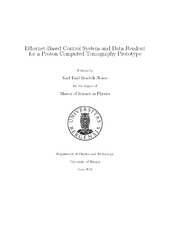| dc.description.abstract | At the University of Bergen (UiB), work is underway to develop a proton based computed tomography prototype. Proton CT (pCT) is an alternative to photonbased imaging that shows great promise as a technology for use in proton treatment planning, while also delivering lower doses of harmful radiation than its X-ray based counterpart. Particle treatment planning is currently achieved by performing X-raybased CT scans, of which the results are used to estimate a particle dose through a translation process. This introduces systemic errors due to the fundamentally different manners in which photons and particles interact with matter. pCT used for dosage planning purposes could eliminate the need for this conversion, allowing for treatment more precise and effective than what is currently possible. The work needed to realize the complete pCT is extensive, and this thesis is primarily concerned with the control system for the multiple proton CT readout units (PRU) that will be used in the machine. This system will facilitate communication between a control room and the readout units, allowing an operator to determine the status of various system parameters such as power consumption, voltages and temperatures, program PRU peripherals according to a desired configuration, perform system initialization, trigger resets, etc. Such a system may also perform other tasks, such as automatic system-monitoring, or could provide assistance in the datareadout process. This thesis discusses the requirements of such a system and how it might be realized, details its design, and describes in addition the full implementation of the required PRU field programmable gate array (FPGA) firmware on the current development board. Software for a soft-core processor running a lightweight OS and instantiated in the FPGA fabric is developed and tested successfully; providing serial- and Ethernet communication links via which a board can be controlled and monitored remotely, using a simple platform-independent API. Additionally, a DMA-based solution for data-readout is designed, implemented, and verified to be working by reading out actual detector data. Other aspects of the system are also discussed, including ways of distributing a synchronized clock and trigger, power-monitoring, and future development. A primer on the workings of a proton CT in addition to particle-/photon matter interaction fundamentals is provided. | en_US |
